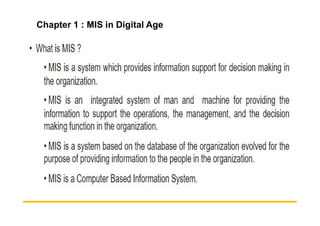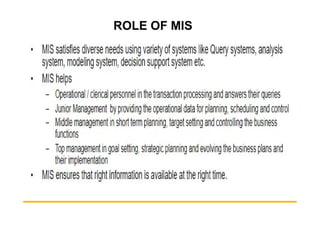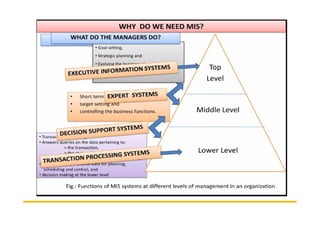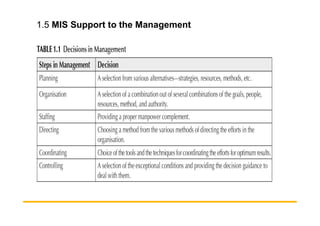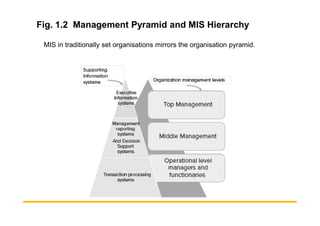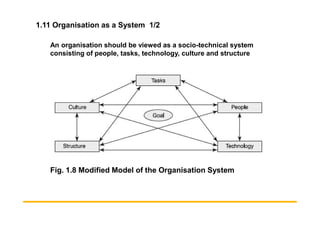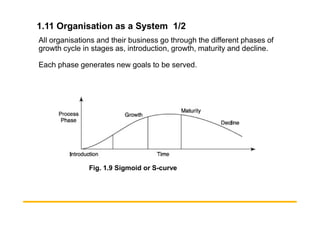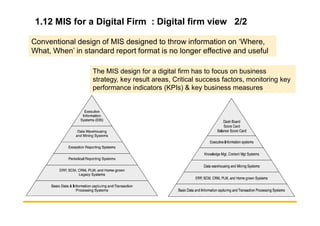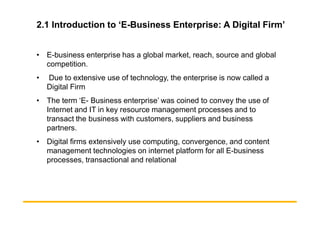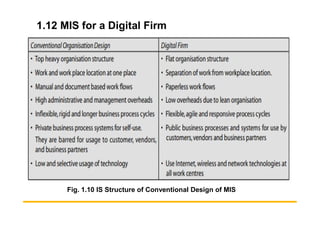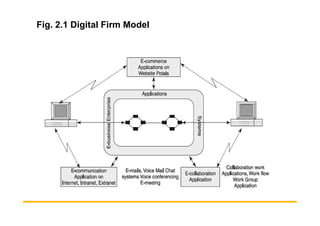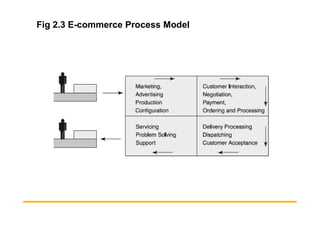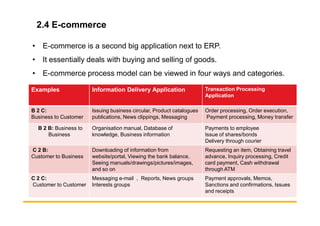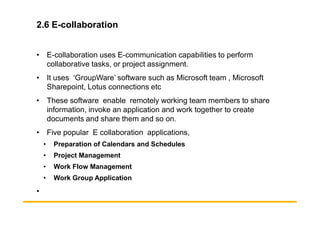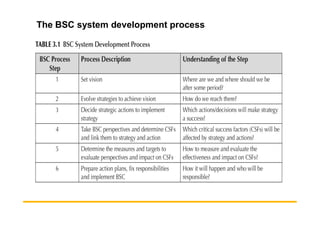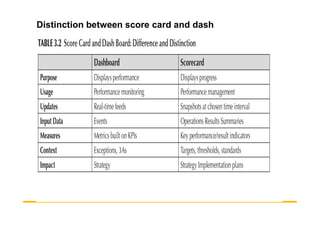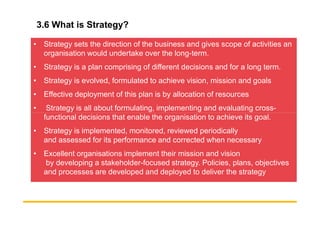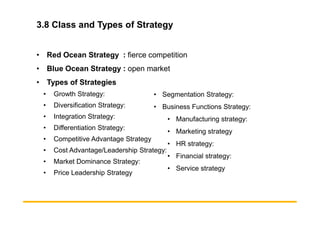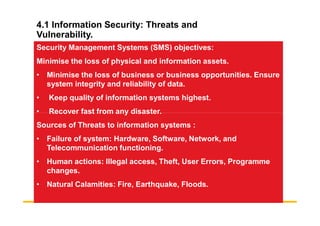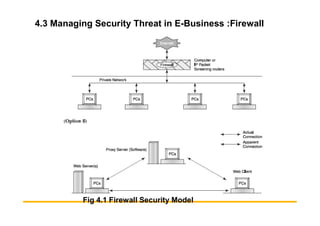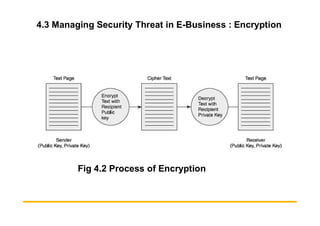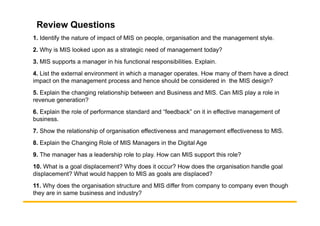Module-1.pdf VTU SYLLABUS 2024 FOR EXAMS
- 2. Chapter 1 : MIS in Digital Age
- 3. ROLE OF MIS
- 5. 1.5 MIS Support to the Management
- 6. Fig. 1.2 Management Pyramid and MIS Hierarchy MIS in traditionally set organisations mirrors the organisation pyramid.
- 7. 1.8 Constituents of MIS MIS is not just software but much more. The five major components are : ŌĆó People ŌĆō users and information systems professionals. ŌĆó Business processes ŌĆō define before software development ŌĆó Data ŌĆō MISŌĆÖs job is to collect, store, process and present data ŌĆó Data ŌĆō MISŌĆÖs job is to collect, store, process and present data ŌĆó Hardware, networking systems ŌĆó Software ŌĆō not only the application software but the system software such as operating systems, data base management systems , programming language, etc.
- 8. 1.11 Organisation as a System 1/2 An organisation should be viewed as a socio-technical system consisting of people, tasks, technology, culture and structure Fig. 1.8 Modified Model of the Organisation System
- 9. All organisations and their business go through the different phases of growth cycle in stages as, introduction, growth, maturity and decline. Each phase generates new goals to be served. 1.11 Organisation as a System 1/2 Fig. 1.9 Sigmoid or S-curve
- 10. The MIS design for a digital firm has to focus on business strategy, key result areas, Critical success factors, monitoring key performance indicators (KPIs) & key business measures 1.12 MIS for a Digital Firm : Digital firm view 2/2 Conventional design of MIS designed to throw information on ŌĆśWhere, What, WhenŌĆÖ in standard report format is no longer effective and useful
- 11. 2.1 Introduction to ŌĆśE-Business Enterprise: A Digital FirmŌĆÖ ŌĆó E-business enterprise has a global market, reach, source and global competition. ŌĆó Due to extensive use of technology, the enterprise is now called a Digital Firm ŌĆó The term ŌĆśE- Business enterpriseŌĆÖ was coined to convey the use of Internet and IT in key resource management processes and to Internet and IT in key resource management processes and to transact the business with customers, suppliers and business partners. ŌĆó Digital firms extensively use computing, convergence, and content management technologies on internet platform for all E-business processes, transactional and relational
- 12. 1.12 MIS for a Digital Firm Fig. 1.10 IS Structure of Conventional Design of MIS
- 13. 2.2 Organisation of Business in Digital Firm Four business models that together work in an E-enterprise Organisation are. 1. E-business 2. E-communication 3. E-commerce 4. E-collaboration
- 14. Fig. 2.1 Digital Firm Model
- 15. Fig 2.3 E-commerce Process Model
- 16. 2.4 E-commerce ŌĆó E-commerce is a second big application next to ERP. ŌĆó It essentially deals with buying and selling of goods. ŌĆó E-commerce process model can be viewed in four ways and categories. Examples Information Delivery Application Transaction Processing Application B 2 C: Issuing business circular, Product catalogues Order processing, Order execution, B 2 C: Business to Customer Issuing business circular, Product catalogues publications, News clippings, Messaging Order processing, Order execution, Payment processing, Money transfer B 2 B: Business to Business Organisation manual, Database of knowledge, Business information Payments to employee Issue of shares/bonds Delivery through courier C 2 B: Customer to Business Downloading of information from website/portal, Viewing the bank balance, Seeing manuals/drawings/pictures/images, and so on Requesting an item, Obtaining travel advance, Inquiry processing, Credit card payment, Cash withdrawal through ATM C 2 C: Customer to Customer Messaging e-mail , Reports, News groups Interests groups Payment approvals, Memos, Sanctions and confirmations, Issues and receipts
- 17. 2.5 E-communication E-communication system is a backbone of all processes whose role is to share information by messages or store information to download on access by the customer. Examples ŌĆó Email , voice-mail for Asynchronous communication ŌĆó Video conferencing or Chat for Synchronous communication ŌĆó Web publishing using websites and portals for storing documents, ŌĆó Web publishing using websites and portals for storing documents, catalogues, drawings, pictures and so on for sharing ŌĆó Enterprise information portal is another tool used for information posting and communication to users or customers. ŌĆó All E-communication systems have sufficient safeguards, which make them secured for use.
- 18. 2.6 E-collaboration ŌĆó E-collaboration uses E-communication capabilities to perform collaborative tasks, or project assignment. ŌĆó It uses ŌĆśGroupWareŌĆÖ software such as Microsoft team , Microsoft Sharepoint, Lotus connections etc ŌĆó These software enable remotely working team members to share information, invoke an application and work together to create information, invoke an application and work together to create documents and share them and so on. ŌĆó Five popular E collaboration applications, ŌĆó Preparation of Calendars and Schedules ŌĆó Project Management ŌĆó Work Flow Management ŌĆó Work Group Application ŌĆó
- 19. Fig. 2.5 E-Collaboration System Model
- 20. 3.3 Balance Score Card, Score Card and Dash Board The Balanced Scorecard provides managers a tool they need to navigate to future competitive success Fig 3.1 Balance Score Card Model
- 21. The BSC system development process
- 22. Distinction between score card and dash board
- 23. 3.6 What is Strategy? ŌĆó Strategy sets the direction of the business and gives scope of activities an organisation would undertake over the long-term. ŌĆó Strategy is a plan comprising of different decisions and for a long term. ŌĆó Strategy is evolved, formulated to achieve vision, mission and goals ŌĆó Effective deployment of this plan is by allocation of resources ŌĆó Strategy is all about formulating, implementing and evaluating cross- functional decisions that enable the organisation to achieve its goal. functional decisions that enable the organisation to achieve its goal. ŌĆó Strategy is implemented, monitored, reviewed periodically and assessed for its performance and corrected when necessary ŌĆó Excellent organisations implement their mission and vision by developing a stakeholder-focused strategy. Policies, plans, objectives and processes are developed and deployed to deliver the strategy
- 24. 3.8 Class and Types of Strategy ŌĆó Red Ocean Strategy : fierce competition ŌĆó Blue Ocean Strategy : open market ŌĆó Types of Strategies ŌĆó Growth Strategy: ŌĆó Diversification Strategy: ŌĆó Integration Strategy: ŌĆó Segmentation Strategy: ŌĆó Business Functions Strategy: ŌĆó Integration Strategy: ŌĆó Differentiation Strategy: ŌĆó Competitive Advantage Strategy ŌĆó Cost Advantage/Leadership Strategy: ŌĆó Market Dominance Strategy: ŌĆó Price Leadership Strategy ŌĆó Manufacturing strategy: ŌĆó Marketing strategy ŌĆó HR strategy: ŌĆó Financial strategy: ŌĆó Service strategy
- 25. Restructuring and divestment strategies focus on consolidation of business Fig 3.9 Strategy Mix for Performance Management
- 26. 4.1 Information Security: Threats and Vulnerability. Security Management Systems (SMS) objectives: Minimise the loss of physical and information assets. ŌĆó Minimise the loss of business or business opportunities. Ensure system integrity and reliability of data. ŌĆó Keep quality of information systems highest. ŌĆó Recover fast from any disaster. ŌĆó Recover fast from any disaster. Sources of Threats to information systems : ŌĆó Failure of system: Hardware, Software, Network, and Telecommunication functioning. ŌĆó Human actions: Illegal access, Theft, User Errors, Programme changes. ŌĆó Natural Calamities: Fire, Earthquake, Floods.
- 27. 4.3 Managing Security Threat in E-Business The Suceesful security measures in E-business are the following: ŌĆó Firewall: Prevent unauthorised userŌĆÖs access. ŌĆó Encryption: Prevent reading of information, messages, reports. reports. ŌĆó Authentication: Confirm the authenticity of a claim of other party. ŌĆó Message Integrity: Ascertaining that communication content is not disturbed. ŌĆó Digital Signature: Confirmation of senderŌĆÖs authenticity.
- 28. 4.3 Managing Security Threat in E-Business :Firewall Fig 4.1 Firewall Security Model
- 29. 4.3 Managing Security Threat in E-Business : Encryption Fig 4.2 Process of Encryption
- 30. Review Questions 1. Identify the nature of impact of MIS on people, organisation and the management style. 2. Why is MIS looked upon as a strategic need of management today? 3. MIS supports a manager in his functional responsibilities. Explain. 4. List the external environment in which a manager operates. How many of them have a direct impact on the management process and hence should be considered in the MIS design? 5. Explain the changing relationship between and Business and MIS. Can MIS play a role in revenue generation? 6. Explain the role of performance standard and ŌĆ£feedbackŌĆØ on it in effective management of 6. Explain the role of performance standard and ŌĆ£feedbackŌĆØ on it in effective management of business. 7. Show the relationship of organisation effectiveness and management effectiveness to MIS. 8. Explain the Changing Role of MIS Managers in the Digital Age 9. The manager has a leadership role to play. How can MIS support this role? 10. What is a goal displacement? Why does it occur? How does the organisation handle goal displacement? What would happen to MIS as goals are displaced? 11. Why does the organisation structure and MIS differ from company to company even though they are in same business and industry?

